The next-gen MacBook Pro with Retina Display Review
by Anand Lal Shimpi on June 23, 2012 4:14 AM EST- Posted in
- Mac
- Apple
- MacBook Pro
- Laptops
- Notebooks
The Software Side of Retina: Making it All Work
OS X, similar to iOS, uses points to represent display coordinates. Traditional OS/display combinations had a 1:1 mapping between points and pixels. Points in OS X are now floating point values, as a single point can be represented by multiple pixels on a high density display.

Images are the same size, but made of 4x the number of pixels on Screen 1 compared to Screen 0
How pixels map to points is determined by the backing scale factor. The backing scale factor can either be set to 1.0 or 2.0. In the case of the former you get 1:1 point to pixel mapping, while in the latter each point is backed by four pixels. The backing scale factor isn’t a global value, it can be set on a per element basis, allowing controls to to be legible while you get the benefits of a higher resolution for additional screen real estate. This aspect of OS X is key to enabling good behavior in applications as you’ll soon see.
Apple does a lot of the display handling for you so you don’t have to think about any of this. All vector based graphics and text using Apple’s APIs are automatically scaled up. Unmodified dialog boxes, toolbars, menus, etc.. should all look “normal” sized and just be ridiculously sharp on the Retina Display. Bitmapped images are scaled up using linear interpolation, but if higher resolution assets are provided OS X can simply swap and use those on a Retina Display.
Applications that render vector graphics, text and other elements to their own backing store will need hand tuning to look good on the Retina Display. These elements will receive the same linearly interpolated upscale I mentioned above.
It’s a bit complicated and confusing so let me try my best to explain what’s going on here in a practical sense. The 15.4-inch Retina Display has a native resolution of 2880 x 1800, that’s 2880 pixels across and 1800 pixels down for a total area of 5,184,000 pixels.
On the Retina MacBook Pro, Apple has done away with conventional resolution settings. Instead you get a horizontal list of scaling options (this applies to external displays as well):
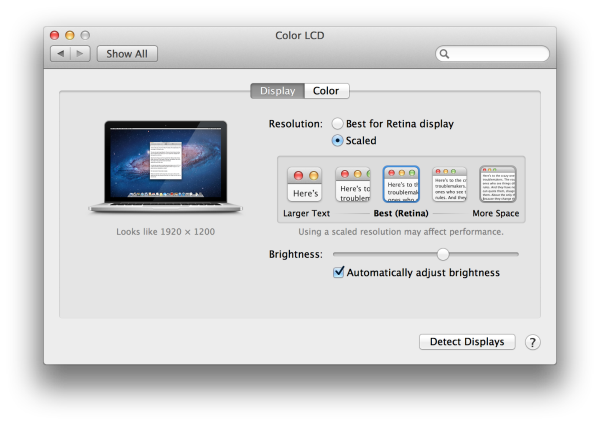
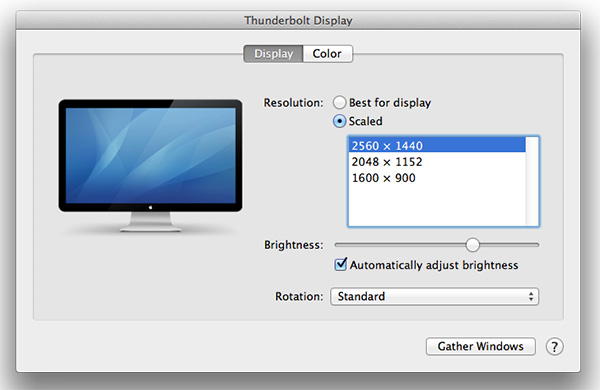
In the default “best for Retina Display” setting, the desktop, menu bar, icons and Finder windows are drawn at 2880 x 1800, but they are drawn larger than they would normally be at 2880. Apple draws everything at 4x the size to make the desktop behave exactly as it would on a 15.4-inch 1440 x 900 display - this is the backing scale factor (2.0) at work. This approach provides the best image quality as there’s integer mapping from pixels on the panel to pixels on the desktop. No interpolation or filtering is necessary.
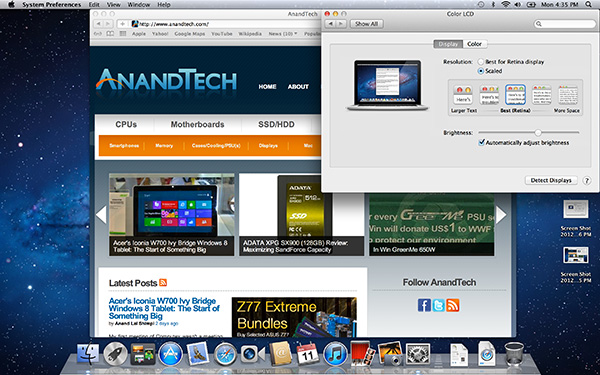
The default "Best for Retina Display" setting, 2880 x 1800 but everything is scaled by 2.0 (4x resolution)
Third party applications without specific Retina Display support also operate in this same “looks like 1440 x 900” mode. If you fire up Chrome, Photoshop or Word you’ll see that everything looks identical to how it would look on a standard resolution 15-inch MacBook Pro. Again, the screen is drawn at 2880 x 1800 but everything is scaled up to be the same size it would be at 1440 x 900.
If third party applications use Apple’s standard methods of drawing text and windows, all of these windows will look super sharp. If they don’t however, whatever routines they use to display windows and text will need to be Retina aware otherwise they run the risk of not scaling text properly. The famous example at this point is Google’s Chrome which has its own offscreen text rendering buffer, even though it uses Apple’s text rendering APIs:
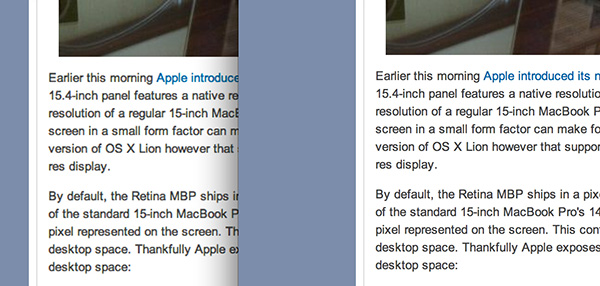
Google Chrome (left) vs. Safari (right) on the rMBP
Chrome Canary fixes the text rendering issue but it has a similar problem displaying images, they simply look better in Safari:
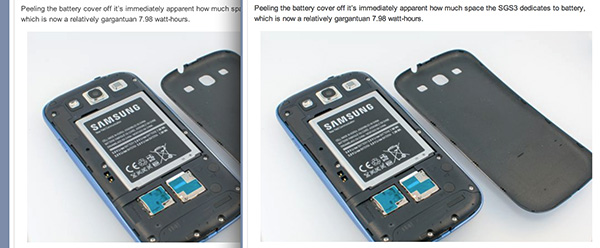
Google Chrome Canary (left) vs. Safari (right) on the rMBP
Even though Adobe had a Retina-aware version of Photoshop running at Apple’s WWDC keynote, the publicly available version of CS6 doesn’t feature the same support. Here even open dialog boxes look bad:
Many of you asked about Office 2011. These apps just work like they would at at 1440 x 900, just with blurrier text unfortunately:
It’s not just third party applications that need updating however, even Apple’s own iWork suite has yet to be updated to take advantage of the Retina Display. As a result text in Pages is incredibly blurry. It has been roughly three years since Apple last updated the iWork suite, so the applications are definitely due for an overhaul. I am a bit surprised Apple didn’t update them at the launch of the rMBP to be honest. It’s quite possible that a major iWork update is imminent and Apple didn’t see the need to update 3 year old software in lieu of that.
Cocoa applications can be forced to open in magnified low resolution or high resolution modes by looking at the app's info window (cmd + i on a selected app in Finder):
Eventually most apps will by default open in high resolution, such as those that have been optimized for Retina Display operation (e.g. iMovie above). Those applications that are not yet Retina aware may default to opening in low resolution mode (e.g. Adium, Pages), in which case they'll look and behave like they would at 1440 x 900 but with all UI elements upscaled to fit the 2880 x 1800 panel. Non-Cocoa applications will have the resolution scaling option greyed out (e.g. MS Office apps).
Where things get really exciting is when you have an application that not only handles scaling properly, but also takes advantage of the added resolution. Take Aperture 3.3 for example. With OS X set to its “best for Retina display” mode, this is what Aperture looks like with a 2880 x 1800 image open and displayed at full size:
Here Apple is scaling the UI elements like the menus and widgets on the screen (backing scale factor = 2.0), but displaying the open image unscaled (backing scale factor = 1.0). As a result we can fit almost an entire 2880 x 1800 image on the screen without zooming out. Remember the backing scale factor isn’t global, individual elements on the screen can be scaled independently depending on their purpose.
The same thing happens when you look at applications like iMovie or Final Cut HD. The UI elements are scaled up but the video window is displayed unscaled, thus allowing us to display a full 1080p video alongside text and tools that are still legible.
It’s all handled amazingly well. It just works.
Oh but there’s more.
If you select the 1680 x 1050 or 1920 x 1200 scaling modes, Apple actually renders the desktop at 2x the selected resolution (3360 x 2100 or 3840 x 2400, respectively), scales up the text and UI elements accordingly so they aren’t super tiny (backing scale factor = 2.0), and downscales the final image to fit on the 2880 x 1800 panel. The end result is you get a 3360 x 2100 desktop, with text and UI elements the size they would be on a 1680 x 1050 desktop, all without sacrificing much sharpness/crispness thanks to the massive supersampling. The resulting image isn’t as perfect as it would be at the default setting because you have to perform a floating point filter down to 2880 x 1800, but it’s still incredibly good.
The same rules as above apply to Retina-aware applications. Take the Aperture example again, this time at “1680 x 1050”:
Note that we can fit the entire 2880 x 1800 image at 100% almost without having to scroll. This is possible because our screen is actually rendered at 3360 x 2100, with the text and UI elements scaled up so they aren’t super tiny, yet the image is left unscaled.
Here’s the same Aperture setup but at “1920 x 1200”:
The 2880 x 1800 image looks downright small since our desktop is rendered at 3840 x 2400. Despite the fact that we’re able to fit everything into a single screen, the text and other UI elements are totally usable at this setting. You get the benefits of additional application real estate without any of the downsides.
What happens if you decide to take Aperture full screen? The image is displayed almost completely at 2880 x 1800. You do lose a little vertical real estate but not much at all.
The 3D gaming experience is even simpler. Here you just choose the appropriate resolution and you get the same scaling you normally would in the game. I’ve already demonstrated support for 2880 x 1800 in titles like Diablo 3, although there is still a need for developer support as we see with the console window in Portal 2:
The flexibility offered by Apple’s handling of the Retina Display in OS X is unparalleled. What applications like Aperture, iPhoto, iMovie and Final Cut HD offer, is unbridled resolution independence. What Apple has done here is so much more difficult than what it pulled off in iOS with the Retina Display. It will take time for third party application developers to get on board, but with the power of the Mac app store and Apple’s growing install base of Mac users I suspect we will see incredibly quick adoption of support for the MacBook Pro’s Retina Display.







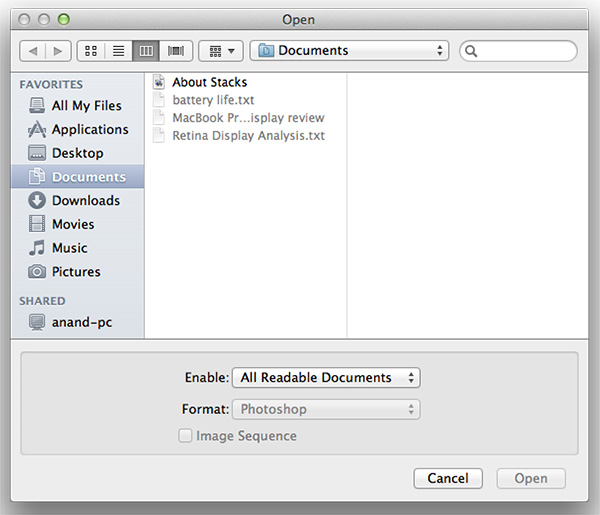
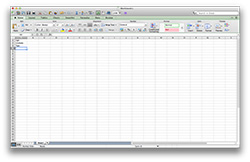
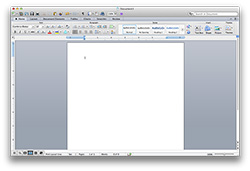
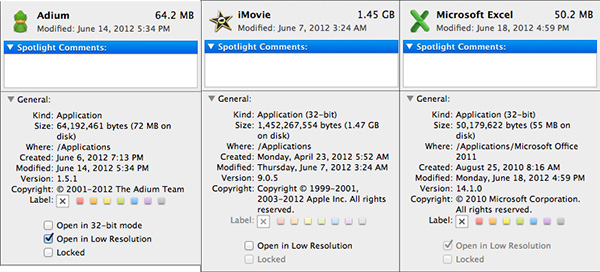

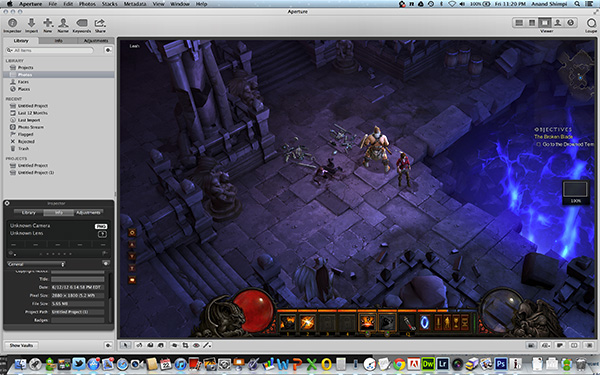
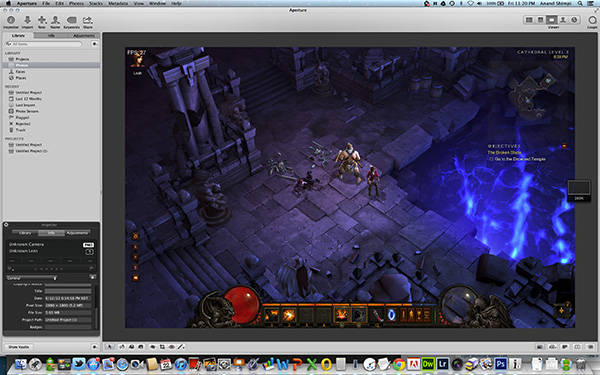
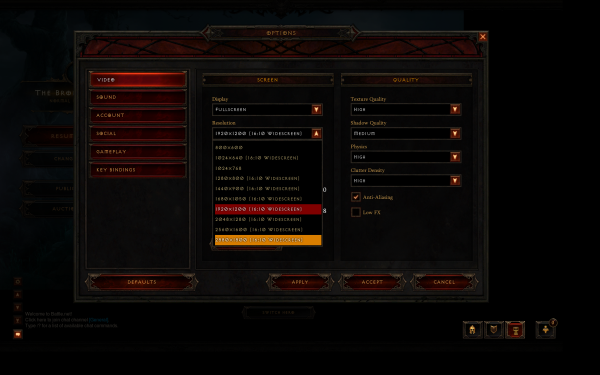
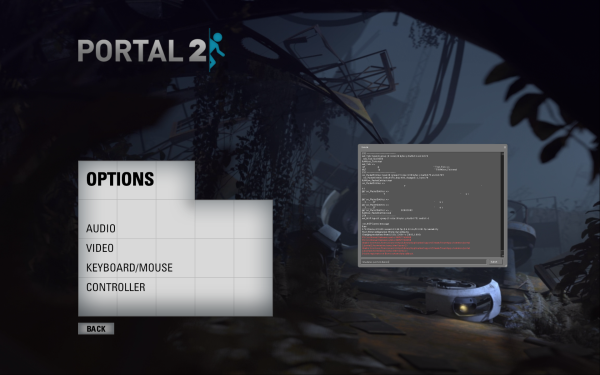








471 Comments
View All Comments
Ohhmaagawd - Sunday, June 24, 2012 - link
It's a first step. There will be retina monitors in the future.Freakie - Monday, June 25, 2012 - link
Lolwut... Monitors that have great quality color are already high resolution... They were pushing major pixels before it was popular ;)vegemeister - Monday, July 2, 2012 - link
With the exception of the (discontinued and originally $10,000) IBM T221 and it's derivatives, no desktop monitor has resolution exceeding 2560x1600, and that resolution is only available in the 30" form factor.Solandri - Saturday, June 23, 2012 - link
I have the lower-end version of that particular laptop ("only" a 1600x900 screen, 2x64 GB SSD). I wish I'd opted for the 1080p screen. 1600p wide isn't really enough to put two apps side-by-side. I do that all the time on my 1920x1200 external monitor though.The screen is a glossy TN panel, but is pretty much the best TN panel I've used. My desktop monitor is IPS so I can see its limitations. But when I'm using the Z in public, the most frequently comment I get is how beautiful the screen is. Sony also does a stellar job with their anti-reflective coatings. it's a glossy screen, but I almost never see reflections (except in sunlight). Colors are a bit too saturated, and the custom color profile I made tones it down. Unfortunately none of the reviews on it tested its gamut. But from photo editing, it's got a wider gamut than most high-end laptop displays I've seen. And it's blindingly bright too - perfectly usable in direct sunlight at max brightness. I rarely run it over half brightness.
The quad-SSD was because the laptop came out before SATA3 SSDs were available (the SATA3 spec had only been finalized a few months prior). 2.5" SSDs were already hitting the limits of SATA2 (3 Gbps) and the only way to get around it was by putting multiple SSDs in a RAID 0 array. So that's what Sony did. The 4-SSD version benchmarks at 430-500 MB/s sequential read/write. Not too shabby in 2010 using 150 MB/s mSATA stick SSDs on SATA2.
Optical drives are more a matter of preference. I end up burning a lot of DVDs so it's definitely convenient. But if you don't do that or watch movies, then yeah I can see it being superfluous. As much as I'd like to see media being distributed on USB sticks, their cost of $1-$2 for 4GB vs. a few cents for a DVD means it's not happening yet. Do note that the Z tops out at 2.9 pounds. It's lighter than the first and second gen Macbook Air despite having a DVD/Bluray drive. That's the second most common comment I get - "It's so light!"
OCedHrt - Sunday, June 24, 2012 - link
The 1080p panel on the Z is IPS. And it's not glossy - you don't have a glass on your laptop. I believe this is more for weight reasons than anything else.maratus - Sunday, June 24, 2012 - link
No, it's not IPS.Solidstate89 - Saturday, June 23, 2012 - link
You have to be the most ignorant jackass I've ever seen. You've basically never even heard of that product until now yet that doesn't stop you from making baseless accusation after baseless accusation.Get the fuck over yourself. And Windows has always handled resolution scaling better than OS X, and it still does.
ananduser - Saturday, June 23, 2012 - link
In 2010 Sony offered a 13" MBP equivalent with matte 1080p TN panel(like all the other macbooks). It had a BluRay built besides a quad raid SSD option(that still exists). The current Z has the video card inside an external dock, it is as slim as the thinnest ultrabook with a full voltage CPU.OCedHrt - Sunday, June 24, 2012 - link
Sony offered it in 2008 :)OCedHrt - Sunday, June 24, 2012 - link
You are not applying the correct context.1080p is okay because windows has DPI scaling - though I agree with Anand that this doesn't work with apps that aren't written correctly. But the same applies to OS X. OS X handles it better because of vector based UI.
It is an IPS display with 92% color gamut that Anandtech called amazing. Don't even try to pretend it sucks: http://www.anandtech.com/show/5530/sony-vaio-z2-ev...
Blu-ray is not a default option, it is an extra configuration that you'd have to pay for. This isn't Apple were talking about - even Sony has typically more options than Apple.
Quad-SSDs. Yes. You need to remember that his happened back in 2008 when SSDs were not doing 500mb/sec. This was back when a quad SSD only netted you about 300mb/sec and before TRIM was prevalent.